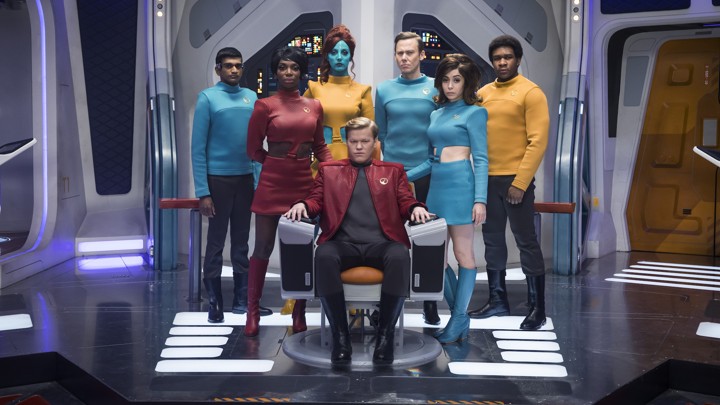The distant future. A galaxy lying open, inviting exploration. You are are part of the bridge crew of an interstellar craft, seeking out new worlds and new life-forms, to expand your civilization's knowledge of their place in the universe. In this game, you all take on the roles of the executive officers on-board your star ship, but you also take turns playing the Captain, directing the ship onward and choosing from the best options presented by the crew. In order to play, you'll need to change many of the assumptions & set-up procedures of A Penny for My Thoughts, but the heart of the mechanics stays the same.
 Starring...
Starring...
Unlike Penny, in this hack you all know who you're playing, in the form of the bridge officer role you will take on: there are some obvious ones to choose from (Science Officer, Security Chief, Comms Officer, Navigator, etc.) but you can make up your own with the agreement of all the players. The choice of bridge officers goes a long way to setting the tone of the game: if you don't have a Gunnery Officer, for example, then you're not going to be fighting many space battles, whereas if you have a Ship's Counselor on the bridge, suddenly diplomatic negotiation becomes much more tenable.
You're free to create any sort of backstory & details you like about your character: are they human, alien, a hybrid or an android? Do they have any unusual skills or natural abilities? What is their personality like and do they have any history with other crew members? You know how to do this.
Red Alerts
Instead of Memory Triggers, you create Red Alerts: these are like pre-credits kickers in the original series of Star Trek, but they can also be twists and turns in an ongoing plot or the cliff-hanger at the end of a two-part episode in later series. They can be simple and obvious (An alien ship suddenly decloaks and charges it's weapons; you receive a distress call from a colony world that is afflicted with plague) or strange and esoteric (A vast, disembodied eye approaches and blocks further progress; Albert Einstein and Al Capone burst onto the bridge and hijack the ship.)
Create about 5 Red Alerts each as usual and place them within reach of all the players; or, if playing on-line as I often do, create a shared spreadsheet for everyone to post their's in.
Mission Structure
From here, the structure of the game plays out more or less as normal, though instead of a Traveler, you have a Captain, and the pennies represent commission and commendation. Also, instead of a separate questionnaire for each player, you can use a shared one that represents a whole episode: this doesn't need any specifically framed prompts on it, e.g. "Recall a pleasant memory," since the framing is largely provided by the Red Alerts drawn and the assumptions of a TV space opera.
As usual, the Reader chooses who goes first by giving them their penny: that player then becomes the Captain for the first act, draws a Red Alert (or uses some other random selector if playing online with a spreadsheet of Red Alerts) and answers guiding questions from the other players. Play continues in the standard way, with the Captain describing what is going on, outlining places, situations and dialogue, until it comes time to take some action.
When the Captain narrates the situation to a point that requires a decisive response, they ask their executive officers for options, picking two to suggest what to do and what the outcome of that action would be. These suggestions must be in keeping with the roles the players have chosen for themselves, so when the Captain asks the Chief Engineer or Science Officer for an option, they're expecting some kind of technobabble solution, but if they turn to the Gunnery Officer, then all hands to battle stations!
 After being presented with two options, the Captain chooses one and gives that officer a commendation (a penny) then continues to narrate as usual until they reach the end of the act. Unlike Penny, each player continues the same story when it is their turn to be Captain, though turns are determined as usual by seeing who has enough pennies in front of them and breaking ties in favour of the player who has not been the Captain for longest.
After being presented with two options, the Captain chooses one and gives that officer a commendation (a penny) then continues to narrate as usual until they reach the end of the act. Unlike Penny, each player continues the same story when it is their turn to be Captain, though turns are determined as usual by seeing who has enough pennies in front of them and breaking ties in favour of the player who has not been the Captain for longest.
A whole episode consists of as many acts as there are players; when you reach the end of an episode (which can be in two parts if that feels right for the narrative, as suggested by the Red Alerts) then you can start a new one. It's up to you whether you reset to the beginning of play for a subsequent episode or, as with Penny, you keep the coins in front of every player as they are and simply require one more to act as the trigger for an act, e.g. the second episode requires a player to have three coins in front of them to become Captain.

This comment has been removed by a blog administrator.
ReplyDelete